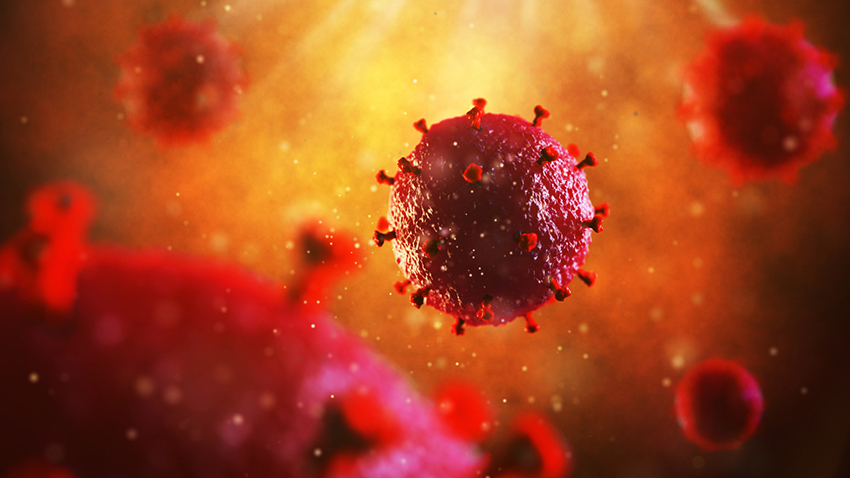Ragon Institute researchers show elite controllers have HIV viral reservoirs in gene deserts which may help prevent viral rebound and contribute to natural control of HIV.
Xu Yu, MD, Ragon Group Leader, recently published a study entitled “Distinct viral reservoirs in individuals with spontaneous control of HIV-1,” in the journal Nature. Yu’s lab, in collaboration with Ragon Group Leaders Mathias Lichterfeld, MD, PhD and Mary Carrington, PhD, and Ragon Director, Bruce Walker, MD, sequenced billions of cells from 64 elite controllers (people living with HIV who suppress the virus naturally without the need for medication), and 41 individuals on antiretroviral drugs (ART). Unlike ART-treated individuals, elite controllers’ viral reservoirs appear to be incapable of being reactivated. This likely helps the elite controllers maintain spontaneous, drug-free control of HIV and may represent a distinguishing feature for a functional cure of HIV infection.
HIV affects more than 35 million people worldwide and can be effectively controlled, but not cured, with a daily regimen of ART. Upon infection, retroviruses like HIV place copies of their viral genetic material into cells’ genomes, creating viral reservoirs, sanctuaries where HIV persists despite ART, throughout the body. When a complete copy of the virus, or intact viral genome, is incorporated into a cell’s genome, it can be used to create new copies of HIV. For people living with HIV, this means that if they stop taking ART, the intact viral genomes previously integrated into the cells’ genomes start making new copies of the virus, leading to rapid viral rebound and disease progression. The HIV viral reservoir has remained a major obstacle to an HIV cure.
Elite controllers’ immune systems use a T-cell mediated immune response to control the virus without medication, to the point that the virus is completely undetectable by standard assays. Understanding the interplay between their immune system and HIV may hold the key to helping the immune systems of people living with HIV to suppress the virus without daily treatment, achieving what is known as a functional cure.
Yu’s group studied the viral reservoir in elite controllers, using next-generation sequencing techniques to precisely map the locations of intact HIV genomes in the human genome. They found that in elite controllers, HIV was often found in locations of the genome that researchers call gene deserts. In these inactive parts of the human genome, human DNA is never turned on, and HIV cannot be effectively expressed but remains in a “blocked and locked” state. This means that HIV is locked in the cell’s genome, and the viral genome is blocked from being used to create more viruses and is therefore incapable of causing disease.
“This positioning of viral genomes in elite controllers,” Yu, says, “is highly atypical, as in the vast majority of people living with HIV-1, HIV is located in the active human genes where viruses can be readily produced.”
When the authors collected cells from elite controllers and infected them with HIV in the lab, they found the virus integrated into active sites in the cell genomes, not in the inactive gene deserts. This suggests that the elite controllers’ unique viral reservoirs may be a result of their HIV-suppressing T cell response eliminating intact viral genomes from active sites.
If researchers are able to identify which viral reservoirs can make new copies of the virus after treatment stops, it may help them to target a treatment against the active, or rebound-competent, reservoirs. This study suggests that if researchers can activate the kind of T cell immunity that is present in elite controllers, they may be able to eliminate rebound-competent viral reservoirs in people living with HIV, achieving a functional cure. The remaining viral DNA, located in non-active parts of the human genome, could be allowed to exist without causing disease.
“NHLBI is interested in understanding how the immune systems of some people living with HIV naturally control their infection without medication,” said Keith Hoots, M.D., Director of the Division of Blood Diseases and Resources at the National Heart, Lung, and Blood Institute, part of the National Institutes of Health, and a veteran HIV researcher himself. “What happens with these individuals, whom we call elite controllers, may shed light on an HIV-1 cure and also help us understand how a person with HIV might control virus and avoid HIV-associated comorbidities.”
Yu’s group had one more finding: one of their elite controller participants had no intact HIV found in over 1.5 billion cells analyzed. This raises the possibility that a “sterilizing cure” of HIV, in which the participant’s immune system has removed all intact HIV genomes from the body, may be achieved naturally in extremely rare instances.
This project was supported by the National Heart, Lung, and Blood Institute, the National Institute of Allergy and Infectious Diseases, the National Institute of Drug Abuse, the National Institutes of Health, the Mark and Lisa Schwartz Family Foundation, the Ragon Institute of Mass General, MIT, and Harvard, the Bill & Melinda Gates Foundation, and the Foundation for AIDS Research (amfAR).


 Ragon Institute
Ragon Institute 